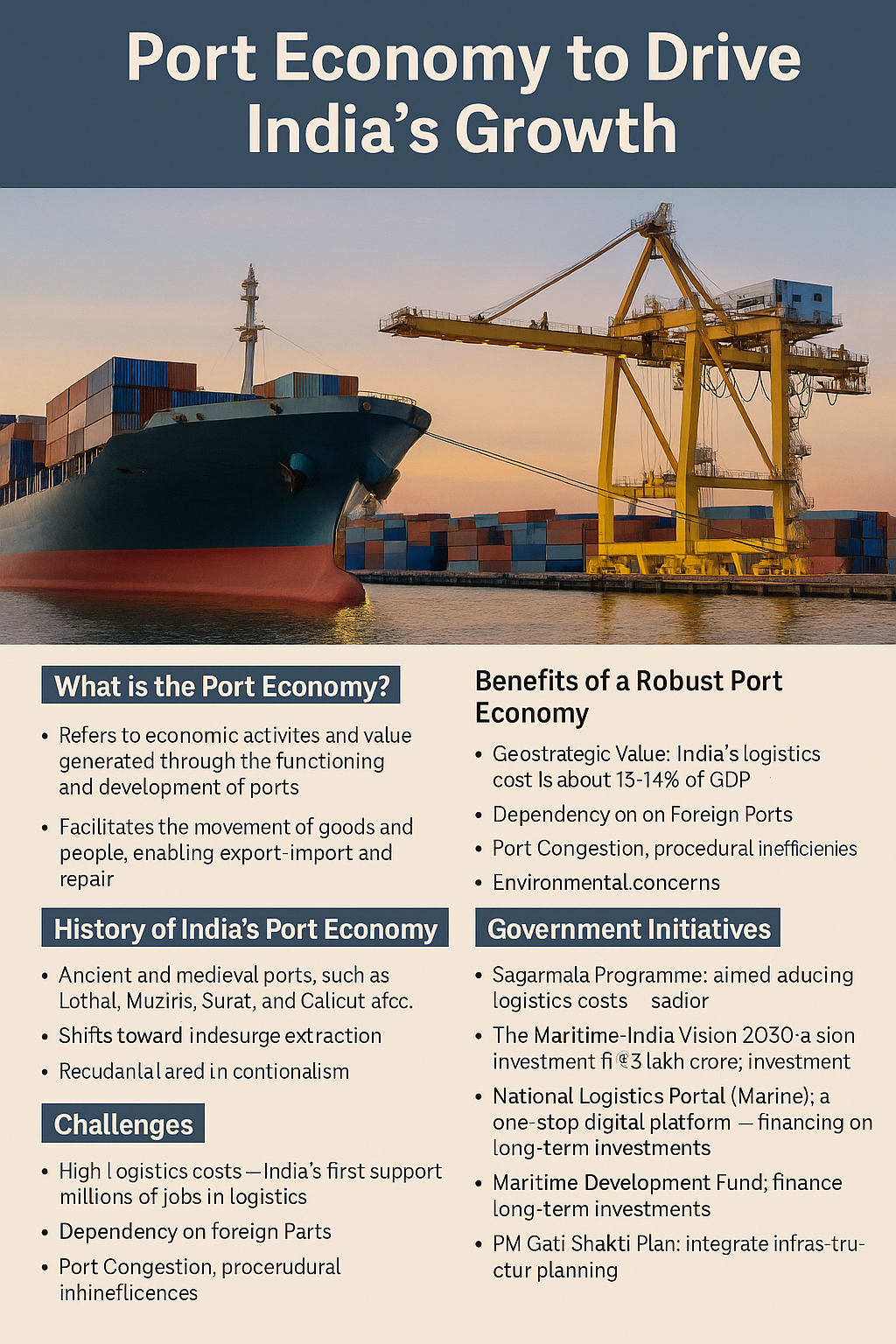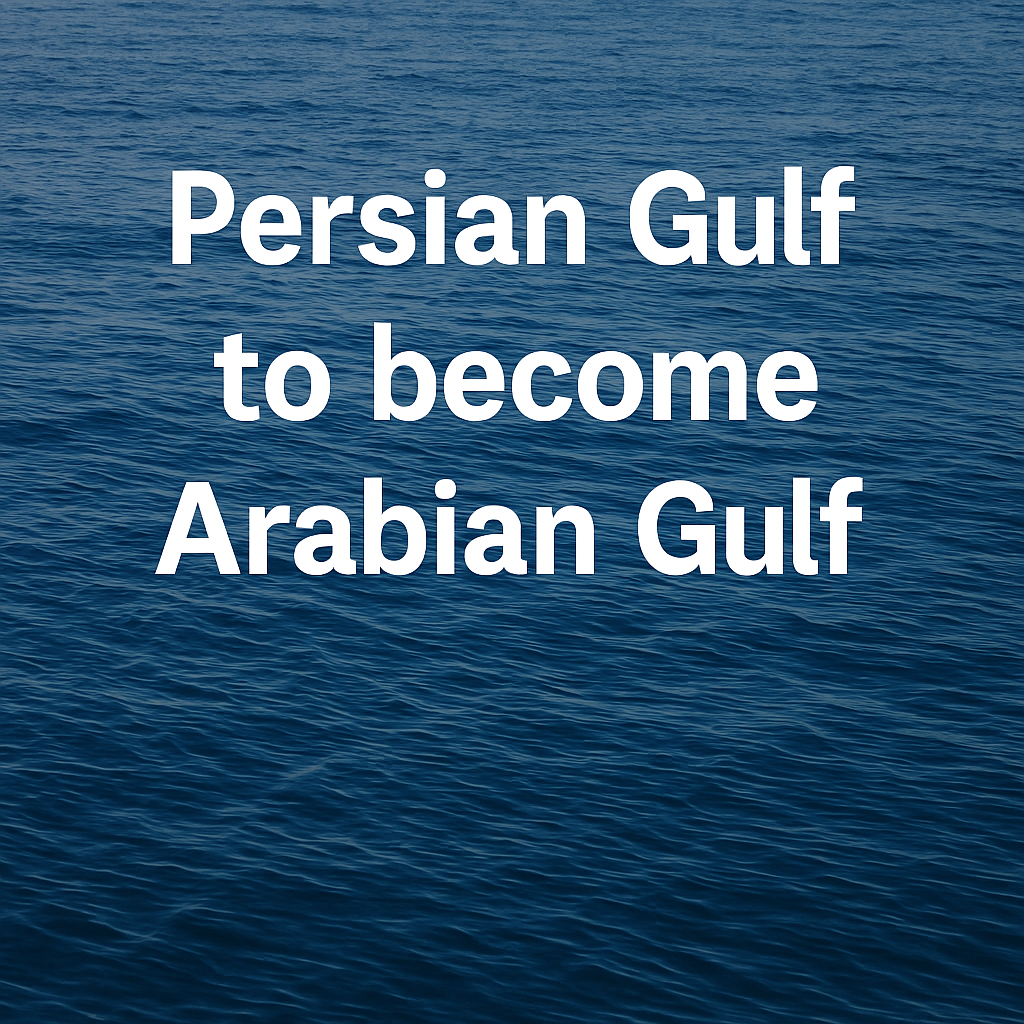
📅 May 3, 2025, Post 2: ⚓ Port Pulse of a Rising India |Mains Essay Attached | Target IAS-26 MCQs Attached: A complete Package, Dear Aspirants!
⚓ Port Pulse of a Rising India

PROJECTS & REPORTS — PETAL 031
📅 May 3, 2025
Thematic Focus: Infrastructure, Maritime Economy, GS III – Economic Development & Logistics
🌿 Opening Whisper
Where waves kiss steel and cargo sings of commerce, India’s ports cradle the dreams of a trillion-dollar tomorrow.
🔍 Key Highlights
• PM Modi commissioned the Vizhinjam International Seaport, India’s first dedicated transshipment port, emphasizing the central role of port cities in national growth.
• NITI Aayog and global logistics rankings show India’s steady rise in maritime performance, with Jawaharlal Nehru Port (JNPA) and Mundra among the top 30 global ports.
• FY24 cargo traffic crossed 819 MT at major ports and 721 MT at non-major ports, highlighting increasing port-led logistics activity.
⚙️ What is a Port Economy?
A port economy refers to the value chain created by trade, logistics, industrial activity, employment, and strategic influence through the functioning of ports. It includes:
- Cargo movement and ship handling
- Logistics and warehousing
- Shipbuilding and repair
- Coastal infrastructure and hinterland industries
🛶 India’s Port Legacy & Status
- Ancient Ports: Lothal, Muziris, and Arikamedu—Indo-Roman and Indo-Greek maritime links
- Medieval Trade Hubs: Surat, Calicut, and Masulipatnam
- Modern Outlook:
– 13 Major Ports and 200+ Non-Major Ports
– 95% of trade by volume & 70% by value through ports
– India ranks 22nd in International Shipments (LPI 2023)
📊 Benefits of a Thriving Port Economy
- Geostrategic Edge
– Supports SAGAR and Project Mausam
– Enhances India’s maritime presence in the Indo-Pacific - Economic Growth & Regional Development
– Port-led development zones attract private investment
– Industrial corridors built around ports increase hinterland connectivity - Environmental Efficiency
– Ports reduce carbon footprints via modal shifts
– IWT emits 50% less CO₂ than road transport - Job Creation
– Ports generate employment in logistics, transport, shipbuilding, and tourism
⚠️ Key Challenges
- High Logistics Cost: 13–14% of GDP
- Foreign Dependence: 75% transshipment via foreign ports (Colombo, Singapore)
- Congestion and Delays: Due to low digitization and poor last-mile connectivity
- Environmental Risks: Dredging and port construction harm coastal ecosystems
🛠️ Government Initiatives
- Sagarmala Programme: Port modernization + Industrialization + Connectivity
- Maritime India Vision 2030: ₹3 lakh crore investment target
- Maritime Development Fund (₹25,000 Cr): Public-Private investment model
- PM Gati Shakti: Infrastructure integration across sectors
- National Logistics Portal (Marine): One-stop digital interface for port stakeholders
🚢 Way Ahead
- Develop Green Ports – Shore power, LNG fueling, eco-friendly dredging
- PPP Model – Attract private investment for infrastructure upgrades
- Global Logistics Hub – Leverage India’s geography near major sea lanes
📘 GS Paper Mapping
Prelims:
• Sagarmala, Maritime India Vision 2030, Vizhinjam Port
• Major/Non-Major Ports
• Maritime Development Fund (MDF)
Mains:
• GS III – Infrastructure & Inclusive Growth
• GS III – Port-led industrialization, logistics efficiency
• GS I – Indian heritage and ancient port towns (Lothal, Muziris)
🔮 A Thought Spark — by IAS Monk
Each port is a breath of the ocean upon our shores—inviting us not just to trade, but to transform
High Quality Mains Essay For Practice :
Word Limit 1000-1200
Port Economy and India’s Maritime Renaissance: Anchoring Growth on the Coastline
In the waves that kiss India’s long and diverse coastline lies an untapped reservoir of economic potential. The term “port economy” is no longer limited to harbours and ships—it signifies a maritime renaissance critical to India’s ambition of becoming a $5 trillion economy. The commissioning of the Vizhinjam International Seaport and initiatives under Sagarmala and Maritime India Vision 2030 highlight the strategic shift toward port-led development. With 13 major ports and more than 200 non-major ones, India is poised to become a logistics hub for the Indo-Pacific.
🌊 The Concept of a Port Economy
A port economy encompasses the economic activities generated by and around ports: trade logistics, industrial hubs, shipbuilding, container movement, storage, and allied services. A single active port can spur thousands of jobs, create export channels for MSMEs, and attract multimodal logistics parks.
In ancient India, ports like Lothal, Muziris, and Arikamedu were vibrant nodes of international commerce. India was once a maritime civilization, trading extensively with Egypt, Rome, and Southeast Asia. The modern revival of this maritime heritage is more than symbolic—it is a strategic and economic imperative.
🚢 Maritime Strength: India’s Current Landscape
India’s ports handle 95% of external trade by volume and 70% by value. With ports like Mundra and JNPA among the top 30 global container terminals, India has begun to carve a place in the global logistics map. According to the World Bank Logistics Performance Index 2023, India ranked 22nd in international shipments, marking a significant leap.
Vizhinjam Seaport, India’s first dedicated transshipment port, will help reduce dependence on foreign hubs like Colombo, Singapore, and Port Klang. At present, over 75% of India’s transshipped cargo is handled abroad, creating a cost and time burden.
The establishment of shipbuilding and repair clusters in Kochi, cargo digitalization portals, and deepwater harbours underlines a shift from port management to port economy.
🛠️ Infrastructure as a Catalyst
Ports are not just loading docks; they are infrastructure ecosystems. Projects under Sagarmala aim to modernize port infrastructure, enhance hinterland connectivity, and reduce logistics cost (currently 13–14% of GDP, compared to 8–9% in advanced economies).
The Maritime India Vision 2030, with a budget of ₹3 lakh crore, envisions over 2,500 MMT of cargo capacity, automation, green ports, and seamless multimodal transport.
The PM Gati Shakti Plan and Bharatmala reinforce this vision by integrating road, rail, and waterways into one unified logistics network, reducing turnaround time and making India competitive globally.
🌍 Geostrategic and Economic Importance
India’s strategic geography, sitting astride major global shipping lanes, gives it an edge. A robust port economy supports:
- SAGAR (Security and Growth for All in the Region) initiative
- Project Mausam and cultural soft power in the Indian Ocean
- Maritime diplomacy with Southeast Asia, Gulf, and Africa
Beyond trade, it becomes a tool of foreign policy, disaster relief, and naval deterrence.
🌱 Environmental and Social Impact
Sustainable ports can become green growth drivers. Inland water transport (IWT) emits 50% less CO₂ per tonne-km compared to roads. Efficient ports reduce truck dependency and cut carbon emissions. However, port construction must guard against coastal erosion, mangrove loss, and marine biodiversity decline.
The government’s push for shore power, LNG bunkering, and electrified cargo handling in future ports can position India as a leader in green logistics.
Socially, ports are employment powerhouses. From dock workers to customs brokers, logistics analysts to tugboat operators, ports create multi-skill, multi-sector jobs—often in economically lagging coastal states.
⚠️ Challenges That Demand Anchoring
Despite progress, systemic challenges persist:
- Overdependence on foreign transshipment hubs
- Port congestion and low digitization of clearance systems
- Fragmented governance between central and state port agencies
- High logistics cost reducing India’s global competitiveness
- Environmental degradation due to poorly planned port expansion
India needs to standardize tariffs, automate customs, and ensure last-mile rail/road linkages to make ports more efficient and sustainable.
🧭 Path Forward: Turning Ports into Growth Engines
- Build Green Ports: Invest in shore-to-ship power, eco-dredging, and bio-barrier protections for marine zones.
- Accelerate PPPs: Private investment in cargo terminals, dry ports, and tech upgrades can catalyze growth.
- Transshipment Independence: Expand Vizhinjam, Karaikal, and Andaman ports to reduce external reliance.
- Digital Maritime Stack: Integrate ports into National Logistics Portal (Marine) for end-to-end cargo visibility.
- Skill and Reskill: Establish maritime skilling academies and training for port workers, especially in eastern and southern India.
✍️ Conclusion
Ports are not just economic gateways; they are symbols of sovereignty, engines of innovation, and anchors of aspiration. As India reclaims its position as a maritime power, the port economy will drive not just cargo—but confidence.
Whether it’s a fishing hamlet in Kerala, a container yard in Gujarat, or a repair dock in Visakhapatnam—India’s coastlines are no longer the edge. They are the beginning of a new national centre of gravity.
“A nation’s greatness lies not just in its cities, but in the harbours where ships carry the dreams of millions.”
Target IAS-26: Daily MCQs : May 3, 2025
📌 Prelims Practice MCQs
Topic: Infrastructure – Ports & Logistics
MCQ 1 — Type 1: How many of the following statements are correct?
Q. With reference to India’s port economy, consider the following statements:
1. Vizhinjam is India’s first fully automated port built exclusively for domestic container traffic.
2. The Sagarmala initiative aims to modernize ports and reduce logistics costs in India.
3. India has more major ports than non-major ports as per the current status.
4. Jawaharlal Nehru Port Authority (JNPA) is among the top 30 container ports globally.
How many of the above statements are correct?
A) Only one
B) Only two
C) Only three
D) All four
🌀 Didn’t get it? Click here (▸) for the Correct Answer & Explanation
✅ Correct Answer: B) Only three✅ Correct Answer: C) Only three
🧠 Explanation:
Statement 4 – Correct
Statement 1 – Incorrect: Vizhinjam is a dedicated transshipment port, not purely domestic.
Statement 2 – Correct
Statement 3 – Incorrect: India has 13 major ports, but 200+ non-major ports.
MCQ 2 — Type 2: Choose the correct statement(s)
Q. Which of the following correctly explains the potential benefits of a robust port economy in India?
1. Reduces dependency on foreign ports for transshipment.
2. Facilitates coastal tourism through Sagarmala Cruise Circuits.
3. Helps shift freight transport to more eco-friendly inland waterways.
4. Leads to reduction in India’s logistics cost, currently among the highest globally.
Choose the correct option:
A) 1, 3, and 4 only
B) 1, 2, and 4 only
C) All four
D) 2 and 3 only
🌀 Didn’t get it? Click here (▸) for the Correct Answer & Explanation
✅ Correct Answer: C) All four
🧠 Explanation:
All four options are correct. Coastal tourism is promoted under the Sagarmala Cruise Tourism component. Modal shifts (road → waterways) reduce emissions and costs.
MCQ 3 — Type 4: Direct factual question
Q. Which of the following ports is India’s first dedicated international transshipment terminal?
A) Ennore Port
B) Mundra Port
C) Vizhinjam Port
D) Kandla Port
🌀 Didn’t get it? Click here (▸) for the Correct Answer & Explanation
✅ Correct Answer: C) Vizhinjam Port
🧠 Explanation:
Vizhinjam, located in Kerala, is India’s first deepwater transshipment port, designed to handle mother vessels and reduce foreign reliance.
MCQ 4 — Type 2: Two-Statement Question
Q. Consider the following statements about India’s maritime sector:
1. The Maritime India Vision 2030 aims to boost cargo handling capacity to over 5,000 million metric tonnes by 2030.
2. The National Logistics Portal (Marine) aims to provide a unified digital platform for all maritime stakeholders.
Which of the statements given above is/are correct?
A) Only 1 is correct
B) Only 2 is correct
C) Both 1 and 2 are correct
D) Neither 1 nor 2 is correct
🌀 Didn’t get it? Click here (▸) for the Correct Answer & Explanation
✅ Correct Answer: B) Only 2 is correct
🧠 Explanation:
Statement 2 – Correct: The National Logistics Portal (Marine) is being developed as a single digital window for port users, customs, shipping lines, etc.
Statement 1 – Incorrect: Maritime India Vision 2030 targets cargo handling of over 2,500 million metric tonnes, not 5,000.


















